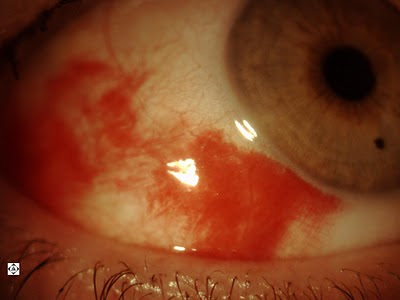During this rough economy everyone is trying to save a buck. What's wrong with making a 2-week disposable contact lens last for a month or two?
Well there are certainly a lot of people who do this without problems. But when there are problems, it is always these people.
What are the problems that develop? On the picture below you can see protein deposits from the tear film that develop on the surface of the contact lens. You can also see blood vessels growing in to the cornea, demonstrating that the cornea is starved for oxygen from contact lens overwear.
These deposits not only make the lens perform less, both in comfort and in vision, but they cause an inflammatory reaction in the eye. Inflammatory bumps begin to form under the eyelid (see picture below). The eyes begin to feel itcy and irritated. The bumps pull on the contact lenses causing them to move more, which causes greater discomfort and fluctuating vision.
Not only do protein deposits form on the contact lenses, but excretions from bacteria in the glands of the eyelids also begin to concentrate on the contact lenses. The eye will have an acute reaction to this, causing ulceration, pain, light-sensitivity, and contact lens intolerance. This occurs without warning. Both these conditions take time to treat and sometimes result in inability to wear contact lenses again in the future.
These situations are very common in the office. The bottom line is, follow the directions of your eyecare provider. There's a reason we want you to replace your contact lenses. Your eyes are worth it!













